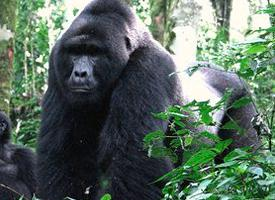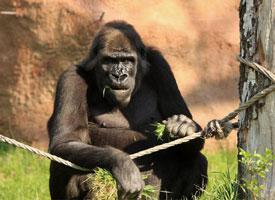
Statut de conservation
| Menacé |
Description de l'animal
The Mountain Gorilla (Gorilla beringei beringei) is a majestic and critically endangered subspecies of the eastern gorilla. Native to the dense, remote rainforests of the Virunga Volcanoes, which span across the borders of Rwanda, Uganda, and the Democratic Republic of Congo, these magnificent creatures have also been found in Uganda's Bwindi Impenetrable National Park, a UNESCO World Heritage site. Known for their profound intelligence and complex social structures, mountain gorillas play a crucial role in their ecosystems and have captured the imagination and empathy of people around the world.Physical Description:
Mountain gorillas are imposing in stature, with adult males often reaching heights of about 6 feet when standing on two legs and weighing up to 440 pounds, making them the largest primates in the world. They possess incredibly strong arms, even longer than their legs, which they use for knuckle-walking. Their fur is thicker and longer compared to other gorilla species, an adaptation that allows them to live in colder temperatures at high altitudes. The males are distinguished by a patch of silver hair on their backs and rumps, earning them the name "silverbacks." Their faces, hands, and feet are bare, with the rest of their bodies covered in dark, coarse hair.
Behavior and Social Structure:
Mountain gorillas are highly social animals, living in relatively stable groups of around 10 to 30 individuals. These groups are led by a dominant silverback, who makes decisions, protects the group from threats, and has breeding rights with the females. The groups also include several younger males, known as blackbacks, along with females and their offspring. Gorillas communicate through a variety of vocalizations, body postures, and facial expressions. They are known for their peaceful nature and, except for occasional displays of power by males, conflicts within and between groups are rare.
Diet and Habitat:
Primarily herbivores, mountain gorillas feed on a variety of plants, including leaves, stems, roots, and fruits, which provide both their nutritional and water needs. Their daily diet consists of large quantities of food, which they spend many hours foraging for across the forest floor and in trees. Mountain gorillas have a home range of up to 15 square miles, although this can vary greatly depending on the availability of food sources.
Conservation Status:
Mountain gorillas were once on the brink of extinction, with their numbers dwindling due to habitat destruction, poaching, and civil conflict. Thanks to concerted conservation efforts, their population has seen a gradual increase, but they remain critically endangered. There are now over 1,000 mountain gorillas in the wild, a significant achievement considering their numbers were estimated at 680 in 2008. Conservation strategies include anti-poaching patrols, veterinary interventions, habitat preservation, and community engagement initiatives aimed at reducing human-wildlife conflict. Eco-tourism also plays a vital role in their conservation, providing much-needed funds for conservation projects and economic benefits for local communities.
In conclusion, the mountain gorilla is a symbol of conservation success and a reminder of the ongoing efforts required to protect these magnificent animals and their habitat. Their survival is closely linked to the health of their ecosystems and the actions of humans, making their conservation a critical issue for both biodiversity and humanity.
Animaux similaires
Nouvelles photos d'animaux
Top 10 des animaux
- Dolphin gull (Leucophaeus scoresbii)
- Diana monkey (Cercopithecus diana)
- Moustached guenon (Cercopithecus cephus)
- Galápagos tortoise (Geochelone nigra complex)
- Russian tortoise (Testudo horsfieldii)
- Stone loach (Barbatula barbatula)
- Japanese macaque (Macaca fuscata)
- Greek tortoise (Testudo graeca)
- Common flying dragon (Draco volans)
- Vendace (Coregonus albula)


